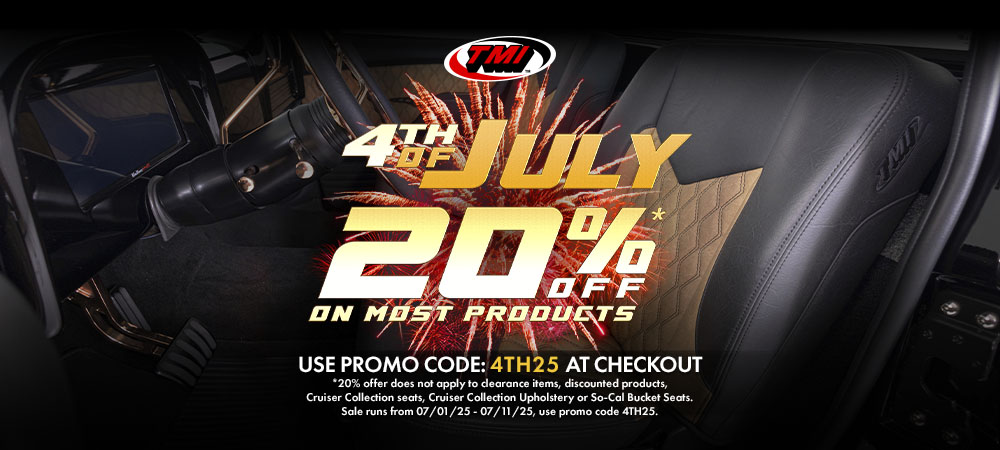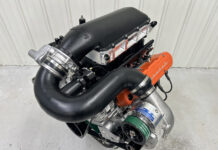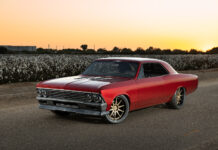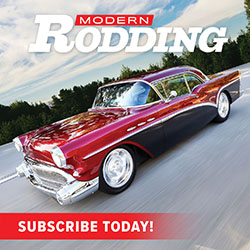By Don Lindfors & Nick Licata – Images by Wes Allison
In 1962, Mr. Stock Eliminator, “Dyno” Don Nicholson, moved from Southern California to Atlanta, to set up and run a Dyno Shop at Naley Chevrolet. Chevrolet had officially pulled out of racing and this was the ad hoc operation for Southern Engineering and Development Company (aka SEDCO), the front for Chevrolet’s secret racing operation.

Hubert Platt was a local racer, along with his brother Houston, who was running a ’38 Chevrolet Gas class car. He and Nicholson hit it off and Nicholson hired both to work in the Naley-Nicholson Dyno operations; Hubert did cylinder head prep, Houston assembled the engines, and Nicholson built engines and did the tuning while running the Dyno. Nicholson had received a new ’62 Bel Air Dual Quad, four-speed, Positraction, 409 direct from Chevrolet as a race car for the new SS/S (Super Super/Stock) Classification: a new class designed for these higher-performance stock cars like the dual-quad 409s, the 406 Fords, 413 Mopar Max Wedge, and Pontiac 421s.

Nicholson convinced Chevrolet to supply Hubert with a car as well and he got this Anniversary Gold Biscayne, which Hubert called “An ugly brown.” Hubert dubbed the car the “Lil General” and adorned it with the well-known “Forget Hell” Confederate Soldier on the doors. This was a different time in our country’s history in the south and the car was quite popular with fans of the day.
Read More: 1962 Chevy Bel Air Resto

With the factory heater, radio, and rear seat delete options, this Biscayne was lighter than the Bel Air Nicholson was running. Standard ’62 409 dual-quad cars were clocked in the quarter-mile at around 14.9 seconds by the magazines of the day. The Nicholson and Platt cars were running in the low 12-second range!

The car came equipped with a 409hp 409 W-block with dual Carter WCFB carbs—the highest rated Chevrolet engine for 1962. After the Naley-Nicholson shop prepped it with cylinder head work and the NHRA legal higher lift cam and meticulous blueprinting, along with Nicholson Built headers (Nicholson learned header building working with Jerry Jardine on the floor of his Duarte, California, garage on his ’61 NHRA record setting car. That experience launched Jardine Headers), the engines were making closer to 450 hp; more than the Z-11 versions that came out the following year. The transmission was a T-10 four-speed and the factory posi rear initially came with a 4.56 gear.

With the added tweaks and more gear in the now Pontiac/Olds 9.3-inch gear, the Nicholson and Platt cars were running as fast as the low 12-second range—a full 2 1/2 seconds quicker than the best the factory had to offer.
Read More: Pro Street 1957 Chevy

Hubert only ran this car for half the season, as Chevrolet sent Nicholson a ’62 409 Impala COPO race car. This one featured an all-aluminum front end and other undisclosed race modifications. Nicholson raced it at the NHRA Indy Nationals in the new B/FX class and beat Dave Strickler in the Bill “Grumpy” Jenkins built Old Reliable III. After this race, Nicholson went back to his top-winning Bel Air and Hubert took over the COPO car, naming it “The Bounty Hunter.”

The “Lil General” was parked at that time and remained at Hubert’s property until 2012—50 years later. The car was sold, and the subsequent owner did a two-year, body-off restoration, getting Hubert’s seal of approval when it was finished. The car spent some time at both Rick Hendrick’s Motorsports Museum and Bill Elliot’s Museum in Georgia.

The car was sold again in 2022, and the buyer lowered the car, added power brakes and steering, and detuned it for street use. He soon realized it was not the car for him and it came up on the Bring A Trailer website in March 2023.
Read More: 1961 Chevy Bel Air 409 Powered Biscayne Conversion

Cole Tachjian of Matt’s Hot Rods Collection saw the car, and after a discussion with Don Lindfors who works for the collection, decided that this car would be a great addition since they already own the ’62 “Dyno” Don Nicholson SS/S Bel Air car.

Cole was able to acquire the car, and Lindfors got to work returning it to its “as-raced” condition and livery. The suspension was backdated with the proper height race springs, sway bars removed, and the power brakes ditched for the original-type manual brakes. New M&H Racemaster 14-inch slicks were mounted up and the engine was brought back to race spec. Lindfors then brought in master lettering and striping legend, Phill Whetstone, to accurately reproduce the original lettering and artwork. When Whetstone went to have the small photo of the artwork enlarged so he could paint it on the car, the print shop was initially hesitant to produce the now-controversial image. When he explained it was for a historical race car restoration, they agreed to do the job.

Times have changed.
The car is now in race-ready condition and will be displayed at the Lion’s Automobilia Foundation and Museum (which is a tribute to the famous Lion’s Drag Strip in Wilmington, California), along with the Nicolson car, throughout 2024, then watch for these two pieces of history to once more storm down the quarter-mile at a few nostalgia drag racing events, and don’t be surprised if you see Cole or Lindfors driving it around Orange, California, as well—slicks and all.

TECH CHECK
Owner: Cole Tachjian, Orange, California
Vehicle: ’62 Chevy Biscayne
Engine
Type: ’62 Chevy W-Series
Displacement: 409 ci
Compression Ratio: 11.5:1
Bore: 0.30 over
Stroke: 3.50 inches
Cylinder Heads: Chevrolet cast-iron 609 model, ported by Hubert Platt and Don Nicholson
Rotating Assembly: Chevrolet Racing forged steel crankshaft, Chevrolet 6.10-inch rods
Camshaft: Custom grind by Don Nicholson
Induction: Original Chevrolet dual-quad aluminum intake, Carter WCFB 500-cfm dual carbs
Air Cleaner: Original Chevrolet 409 dual-quad open element
Ignition: Delco
Wires: Moroso
Assembly: Fulton Competition Racing Engines (Spartanburg, SC)
Machine Work: Fulton Racing Engines
Valve Covers: Original 409
Headers: Originally Nicholson, now Hooker 1 7/8 inch
Exhaust: 3-inch electric cutouts off header collectors, 2 ½ exhaust, Flowmaster 40-series mufflers
Ancillaries: ’63 Delco alternator, aluminum radiator, original steel 20-gallon fuel tank
Output: 526 hp at 5,600 rpm, 548 lb-ft torque at 4,400 rpm
Drivetrain
Transmission: BorgWarner T-10
Shifter: Original Chevrolet
Rear Axle: Pontiac/Olds 9.3-inch, 4.11 gears, stock axles
Chassis
Front Suspension: Stock GM IFS, stock spindles, stock power steering, stock control arms, 600-pound SECO Super Stock springs
Rear Suspension: Chevrolet four-link, Chevrolet original Panhard bar, 325 pound springs, Delco shocks
Brakes: 11-inch drum, Chevrolet dual master cylinder, stock pedals
Steering: Saginaw
Wheels & Tires
Wheels: Chevrolet Steelies, 14×7 front and rear
Tires: BFGoodrich Silverton 8.00-14 front, M&H Racemaster Slicks 8.00/850-14 rear
Interior
Upholstery: Stock, fawn carpet and door panels
Installation: Chevrolet
Seats: Factory bench, rear seat delete option
Steering: Original
Shifter: Original Chevrolet
Dash: Stock with radio and heater delete options
Instrumentation: Stock with Sun 8,000-rpm tach
Pedals: Original
HVAC: Windwings wide open
Exterior
Paint: Anniversary Gold (Hubert called it “Ugly Brown”)
Lettering and Graphics: Phill Whetstone
Hood: Steel
Click on this issue’s cover to see the enhanced digital version of Original 1962 Chevy Biscayne raced by Hubert Platt.























































